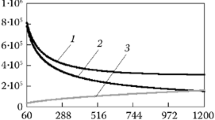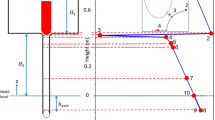Abstract
Using a semi-discrete model that describes the heat transfer of a continuous casting process of steel, this paper is addressed to an optimal control problem of the continuous casting process in the secondary cooling zone with water spray control. The approach is based on the Hamilton–Jacobi–Bellman equation satisfied by the value function. It is shown that the value function is the viscosity solution of the Hamilton–Jacobi–Bellman equation. The optimal feedback control is found numerically by solving the associated Hamilton–Jacobi–Bellman equation through a designed finite difference scheme. The validity of the optimality of the obtained control is experimented numerically through comparisons with different admissible controls. Detailed study of a low-carbon billet caster is presented.
Similar content being viewed by others
References
Bardi, M., Capuzzo-Dolcetta, I.: Optimal Control and Viscosity Solutions of Hamilton–Jacobi–Bellman Equations. Systems & Control: Foundations & Applications, Birkhäuser, Boston (1997)
Barron E.N. (1990). Application of viscosity solutions of infinite-dimensional Hamilton– Jacobi–Bellman equations to some problems in distributed optimal control. J. Opti. Theory Appl. 64: 245–268
Brimacombe J.K. (1976). Design of continuous casting machines based on a heat-flow analysis: state-of-the-art review. Can. Metallurg. Q. 15: 163–175
Cannarsa P., Gozzi F. and Soner H.M. (1993). A dynamic programming approach to nonlinear boundary control problems of parabolic type. J. Funct. Anal. 117: 25–61
Carlini E., Falcone M. and Ferretti R. (2004). An efficient algorithm for Hamilton–Jacobi equations in high dimension. Comput. Vis. Sci. 7: 15–29
Cecil T., Qian J., and Osher S. (2004). Numerical methods for high dimensional Hamilton–Jacobi equations using radial basis functions. J. Comput. Phys. 196: 327–347
Crandall, M.G.: Viscosity solutions: a primer. In: Viscosity Solutions and Applications. Lecture Notes in Math, vol. 1660, pp 1–43. Springer, Berlin Heidelberg New York (1997)
Fleming, W.H., Soner, H.M.: Controlled Markov Processes and Viscosity Solutions. Applications of Mathematics; vol. 25, Springer, Berlin Heidelberg New York (1993)
Gozzi F., Sritharan S.S. and Świåch A. (2002). Viscosity solutions of dynamic-programming equations for the optimal control of the two-dimensional Navier-Stokes equations. Arch. Ration. Mech. Anal. 163: 295–327
Guo B.Z., Xia X., Camisani-Calzolari F.R. and Craig I.K. (2002). A semi-discrete approach to modelling and control of the continuous casting process. Steel Res. 71: 220–227
Kocan M. and Soravia P. (1998). A viscosity approach to infinite-dimensional Hamilton–Jacobi equations arising in optimal control with state constraints. SIAM J. Control Opti. 36: 1348–1375
Laitinen E. and Neittaanmäki P. (1988). On numerical simulation of the continuous casting process. J. Eng. Math. 22: 335–354
Li R.H. and Feng G.C. (1980). Numerical Solution of Differential Equations. Higher Education Press, Shanghai (in Chinese).
Li X.J. and Yong J.M. (1995). Optimal Control Theory for Infinite Dimensional Systems. Systems & Control: Foundations & Applications, Birkhäuser Boston, Boston
Miettinen K., Mäkelä M.M. and Männikkö T. (1998). Optimal control of continuous casting by nondifferentiable multiobjective optimization. Comput. Opti. Appl. Int. 11: 177–194
Miettinen K., Mäkelä M.M. and Toivanen J. (2003). Numerical comparison of some penalty-based constraint handling techniques in genetic algorithms. J. Glob. Opti. 27: 427–446
Sontag E.D. (1990). Mathematical Control Theory: Deterministic Finite Dimensional Systems. Springer, Berlin Heidelberg New York
Stoer J. and Rulisch R. (1993). Introduction to Numerical Analysis. Springer, Berlin Heidelberg New York
Bulirsch R. and Stryk O. (1992). Direct and indirect methods for trajectory optimization. Ann. Oper. Res. 37: 357–373
Wang S., Gao F. and Teo K.L. (2000). An upwind finite-difference method for the approximation of viscosity solutions to Hamilton–Jacobi-Bellman equations. IMA J. Math. Control Inform. 17: 167–178
Wang S., Jennings L.S. and Teo K.L. (2003). Numerical solution of Hamilton–Jacobi–Bellman equations by an upwind finite volume method. J. Glob. Opti. 27: 177–192
Zhou X.Y. (1993). Verification theorems within the framework of viscosity solutions. J. Math. Anal. Appl. 177: 208–225
Author information
Authors and Affiliations
Corresponding author
Rights and permissions
About this article
Cite this article
Guo, BZ., Sun, B. Numerical solution to the optimal feedback control of continuous casting process. J Glob Optim 39, 171–195 (2007). https://doi.org/10.1007/s10898-006-9130-0
Received:
Accepted:
Published:
Issue Date:
DOI: https://doi.org/10.1007/s10898-006-9130-0




